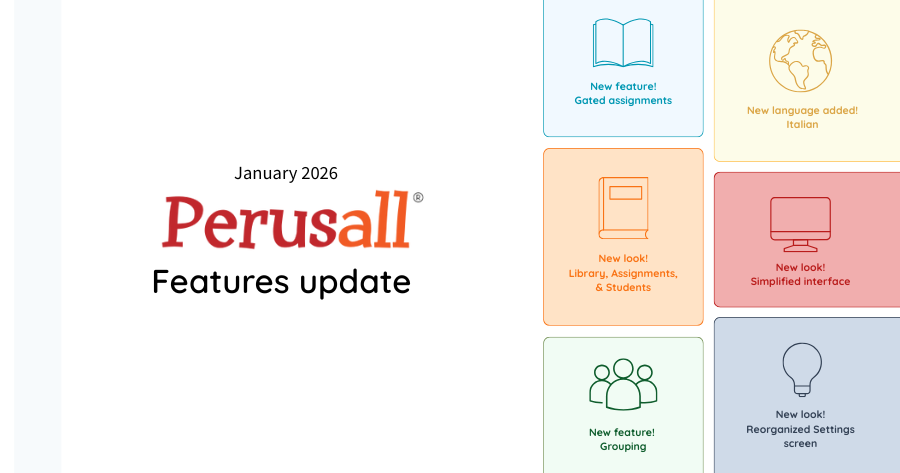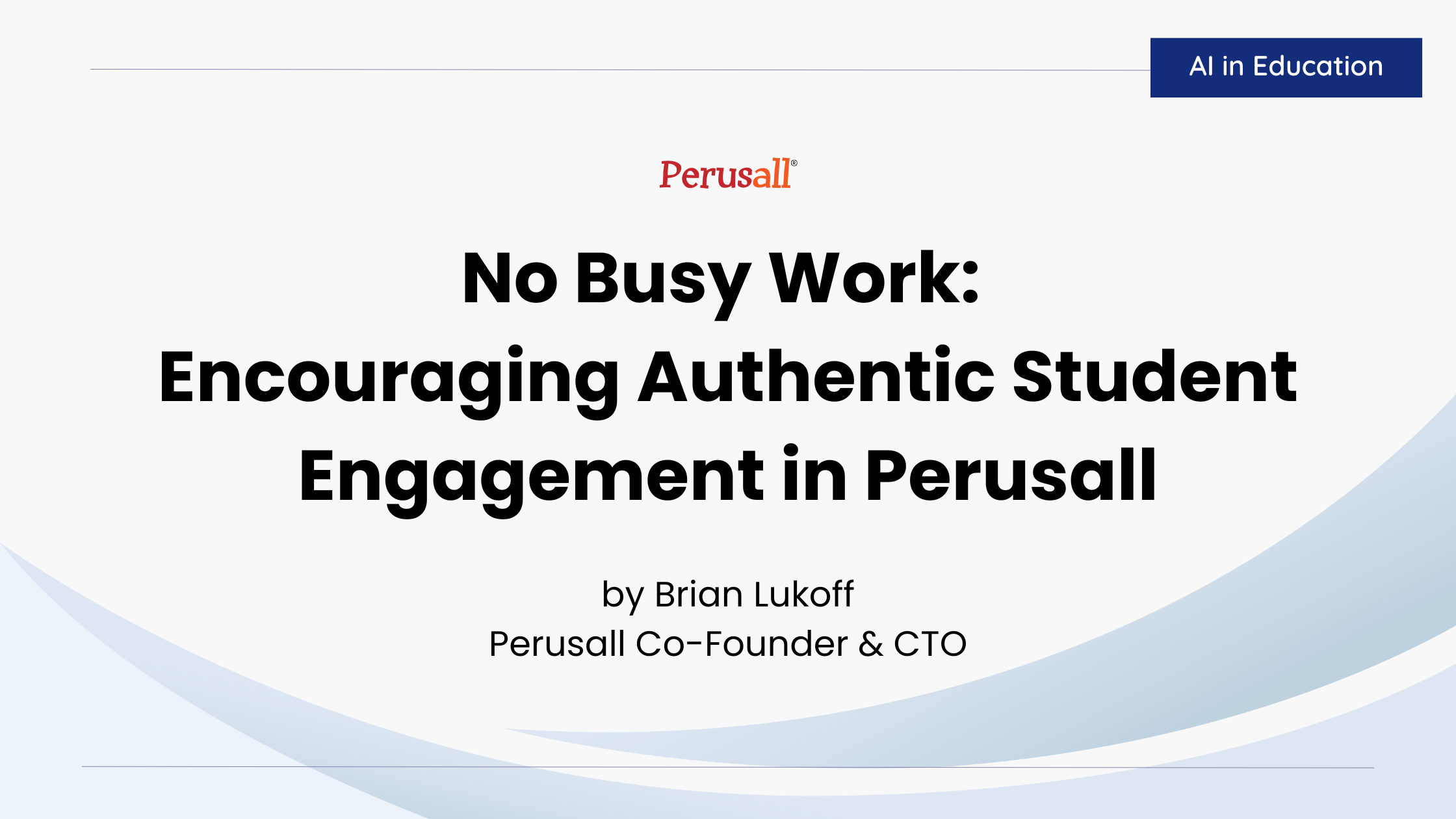It’s that time of year again! The fall semester will be upon us before we know it, and while you’re hopefully enjoying summer, you’re probably starting to prepare for the new semester. For Perusall users, you will notice a few new options and features. More options mean more flexibility to use Perusall in a way that fits our teaching philosophies and meets our pedagogical needs. In this post, I’ll cover the more significant changes and explain how they make your grading life easier. By the end of this post, you’ll see that Perusall’s updates will knock a few items off your to-do list!
To see a walk-through of all the new Perusall features, please join co-founder and fellow educator, Brian Lukoff, for a walk-through on Tuesday, August 2nd from 12:00-1:00 p.m. EDT. Register to attend today!
Scoring Presets: Focus on Pedagogical Purpose
The new scoring presets are my personal favorite of the updates. Preset scoring options allow you to select the grading schema that best fits your purpose for using the technology. Our use of technology in the learning space should always be driven by the tool’s ability to help students reach established course learning outcomes, and I’m excited that the introduction of these scoring presets helps us put pedagogy first. We still have access to the “Holistic” and “Content Only” grading options, but now we can also choose from “Focus on Reading/Watching,” “Focus on Social Engagement,” and “Focus on Quizzes.” (More on the new quiz feature below.) These focus areas prompt us to reflect on why we’re using Perusall: what do we want students to get out of the experience?

Rather than having to ponder this question and then generate a grading schema to match, we can easily select the preset that meets our needs and, if we so desire, further customize the suggested settings. As you can see in the screenshots below, each of the scoring targets is color-coded and visually expands based on its assigned percentage. In the first screenshot set to “Focus on Social Engagement,” each of the targets is weighted fairly evenly at either 20% or 30%, with the slightly higher weight given to the student-student engagement behaviors of writing quality annotations that get responses and upvotes from other students. When I change the preset to “Focus on Reading/Watching,” the “Reading to End” and “Active Engagement Time” targets expand to 40% each while the other targets shrink to 10% or 20%. In the first screenshot, the “Options” drop-down allows an instructor to attach a specific number goal to the percentage value attached to the scoring component.
Screenshot 1: Preset Scoring for “Focus on Social Engagement”

Screenshot 2: Preset Scoring for “Focus on Reading/Watching”

Pedagogy aside, this update removes one of the more substantial barriers for instructors new to Perusall. In the five years I’ve been training instructors on how to use Perusall, I’ve seen more than a few decide not to use Perusall because the grading was too complicated to set up. Others chose to use Perusall but ignore the autograding feature entirely (more on that in a moment) to make it easier to manage. Preset scoring takes the guesswork out of creating a grading schema that aligns with the way you want to use Perusall.
Grading and Analytics Options
For some instructors, however, finding a grading schema that aligns with your pedagogy might mean not using the autograding feature for any number of reasons. A growing body of research on the problems with traditional grading has fueled the ungrading movement as instructors seek alternative means to motivate and more equitably assess their students. With the rise and misuse of analytics, an increasing number of instructors have also begun to express justified concerns about the data we collect about our students through learning technologies. Perusall’s updates to their analytics options demonstrate a responsiveness to these concerns. If autograding or the use of learning analytics do not align with your teaching philosophy, Perusall allows you to disable these features under the “General” setup tab. We now have four options: “Automatic Grading and Engagement Analytics,” “Manual Grading and Engagement Analytics,” “Disable Grading but provide Engagement Analytics,” and “Disable all Analytics.” The first and last options are fairly self-explanatory. The key difference between “Manual Grading” and “Disable Grading” is the disappearance of the gradebook altogether. “Manual Grading” provides you the space to record grades whereas “Disable Grading” eliminates the gradebook from Perusall.
Grading and Analytic Options

Because grades are so often the sticking point for students, Perusall has made it easier for instructors to understand and explain a student’s grade breakdown. The “Grade Assignment” feature becomes visible after the assignment deadline has passed. Instructors can see the calculations for each enabled grading target by individual students. If a student expresses concern about the fairness of a grade in Perusall, instructors can now turn to this insightful breakdown to explain why the student received that grade. If for any reason you decide to change the student’s score, Perusall still allows manual overrides in the gradebook.

Streamlined LMS Sync
If you’re fortunate enough to have the Perusall integration with your campus LMS enabled, you may be familiar with the tedious process of linking Perusall assignments within your modules to enable gradebook syncing. Those days are gone, and no one is missing them! Perusall’s recent upgrade to LTI 1.3 enables grade passback from the platform to your LMS without the use of specific links. Instructors can now select from a list of available Perusall assignments within their LMS, or (in Canvas) Perusall will automatically create assignments in the LMS. Alternately, instructors can simply use one link in the LMS for students to launch Perusall, and LTI 1.3 allows us to still sync back individual assignment scores into separate gradebook columns for each assignment.
But wait, there’s more! The LTI upgrade also enables a full roster sync with your LMS. Previously, students had to push out to Perusall from the LMS to show up in the Perusall gradebook. If a student never logged into Perusall, they would never appear in the gradebook. Now the roster from your LMS will automatically port into Perusall when you establish the link with your course. This upgrade also means that groups and group names you create in the LMS will port automatically into Perusall. No more manual group setup.

Quiz Feature
Instructors have been asking for a quiz feature as long as I’ve been offering training, and now Perusall has delivered. At the moment, the only format Perusall supports is multiple choice, but well-designed multiple choice questions offer an easy yet effective option for assessing student comprehension that complements what we can learn from their annotations. Quizzes appear under the “Library” tab as content you can add. While creating the quiz, you can add an explanation for the correct answer. Also, you can create an assignment specifically for the quiz or add it as part of another assignment.
Creating a Quiz with Explanations

I encourage you to get creative in your use of quizzes such as soliciting student opinions or asking them to apply a new concept while simultaneously cautioning you against reinstating the completion quizzes of pedagogies past. Before Perusall, completion quizzes were often an effective means of getting students to do the reading or watch the video, etc. In my experience, however, using quizzes in this manner made me feel like the assignment police and made my students feel like I was punishing them rather than motivating them to engage in productive learning behaviors. Perusall already holds students accountable for engaging with the assigned material, and in my experience, it does so much more effectively than any quiz ever could. With that caveat out of the way, I look forward to learning about the innovative uses Perusall instructors will find for the quiz feature at next year’s Perusall Exchange.
Improved Logistics
Before wrapping up, I wanted to highlight a few of Perusall’s new grade-related logistics options that improve both flexibility and ease of use. Since it’s fairly common practice to set online deadlines to 11:59 pm, Perusall has added an “End of Day” shortcut button to its assignment submission deadline calendar. Selecting the option automatically sets the time to 11:59 pm.

To motivate students to engage more with the assignment, Perusall now offers a grade release option between the assignment deadline and the late annotation and post-deadline reply windows. The idea behind this feature is to encourage students who did not score as well as they hoped to return to the assignment for an improved score. Though some instructors might be concerned that this feature only promotes grade grubbing, I would argue that it can be used and explained to students as a means of learning how to engage effectively with the assignment and with other students in the course. You might use this as a scaffolding tool to help students understand what types of thoughts and behaviors are expected from them when engaging in Perusall. As students begin to understand how to succeed in Perusall, you might disable this feature. Alternatively, if one of your pedagogical purposes for using Perusall is to foster ongoing dialogue between students, you might want to leave this option enabled and remind students that they can be rewarded for productively continuing the conversation.
I hope this overview of Perusall’s new grading-related features has you excited to explore the possibilities. Be sure to share your innovations at next year’s Perusall Exchange!



.png)





